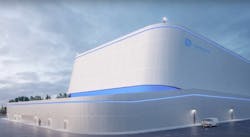GE Vernova Hitachi Nuclear Creating SMR Engineering and Service Center in Ontario
GE Vernova Hitachi Nuclear Energy will create a new engineering and service center focused around its pending BWRX-300 advanced small modular reactor (SMR) project to be built in Ontario, Canada.
The joint venture of GE Vernova (formerly GE Power) and Hitachi Energy is planning to establish the Canadian BWRX-300 center in the Durham region near utility power generator Ontario Power Generation’s (OPG) Darlington New Nuclear Project site. The Province of Ontario Government and OPG previously selected the BWRX-300 and approved construction for the four-reactor SMR site at Darlington, which is also home to a long-running conventional nuclear power plant.
The Darlington SMR project would include construction of the first of four planned BWRX-300s, with the first unit scheduled for completion by the end of 2030.
GE Vernova Hitachi Nuclear plans to use the engineering and service center to be a hub for operations and maintenance work, innovation, research, supply chain engagement and workforce development around the BWRX-300. SMR and advanced microreactors are envisioned as the next phase in nuclear energy development.
The companies announced the engineering and service center location and timeline Monday during an event with Ontario Minister of Energy and Mines Stephen Lecce.
“The Canadian BWRX-300 Engineering and Service Centre will bolster Ontario’s position as a nuclear leader and further cultivate Canada’s nuclear energy workforce with an industry-leading training ecosystem,” said Heather Chalmers, President & CEO, GE Vernova Canada, in a statement. “This Ontario-based hub will provide the province with continued access to the best and brightest talent and innovation in the nuclear energy industry while complementing global efforts for deploying the BWRX-300.”
No SMRs have yet been built in the U.S. or Canada, but proponents see advanced and modular reactor design as a must-do for future baseload and carbon-free generation. Nuclear reactors have a high capacity-factor and do not emit greenhouse gases during generation, but they are considered expensive and difficult to build.
A looming data center load expansion is predicted to add perhaps 50 GW of demand by the early 2030s, if not more. SMR nuclear is considered a sustainable and efficient power resource to meet the rise of artificial intelligence training models and cloud-based computing capacity.
OPG estimates that power demand could triple in Ontario alone by 2050. The utility also has set net-zero goals for 2040.
The 300-MW BWRX-300 is a smaller boiling water reactor version of previous GE Hitachi Nuclear Energy designs. GE Power became GE Vernova when parent company General Electric split off into three separately traded entities in the last year.
Conventional reactors account for 18% of utility-scale electricity generation in the U.S. and about 15% in Canada, according to reports. Most of those Canadian nuclear reactors operate in Ontario.
“Ontario is proud to lead the world in next-generation nuclear innovation, creating good-paying local jobs, training thousands of skilled workers and delivering clean, reliable power for decades to come,” Ontario Provincial Energy and Mines Minister Lecce said. “By locking in this investment from GE Vernova we are reinforcing our plan to make Ontario a clean energy superpower where our workers build with Canadian materials, operate with Canadian expertise and export the clean technology the world needs.”
GE Vernova Hitachi Nuclear has parallel engineering and service operations work planning underway in Wilmington, North Carolina. The company hopes to complete the Ontario facility and put it into operation by the end of 2027.
The planned center would include a virtual reality simulator and provide training capabilities around work on the BWRX-300. The center also will develop advanced maintenance and inspection technologies for the reactors.
GE Vernova Hitachi Nuclear also plans to work with OPG, engineering firm AtkinsRealis and construction contractor Aecon on the Darlington SMR project. In addition, the GE Vernova Hitachi joint venture last year added Canadian-based Worley Chemetics to design and fabricate the isolation condenser system for the BWRX-300.
Other North American companies working on various phases of SMR collaboration, design and construction permit applications include X-energy, NuScale Power, NANO Nuclear and Kairos Power, among others.
The U.S. Department of Energy is working to try and fast-track some SMR pilot programs through a process separate from the Nuclear Regulatory Commission approvals.
About the Author
Rod Walton, EnergyTech Managing Editor
Managing Editor
For EnergyTech editorial inquiries, please contact Managing Editor Rod Walton at [email protected].
Rod Walton has spent 17 years covering the energy industry as a newspaper and trade journalist. He formerly was energy writer and business editor at the Tulsa World. Later, he spent six years covering the electricity power sector for Pennwell and Clarion Events. He joined Endeavor and EnergyTech in November 2021.
Walton earned his Bachelors degree in journalism from the University of Oklahoma. His career stops include the Moore American, Bartlesville Examiner-Enterprise, Wagoner Tribune and Tulsa World.
EnergyTech is focused on the mission critical and large-scale energy users and their sustainability and resiliency goals. These include the commercial and industrial sectors, as well as the military, universities, data centers and microgrids. The C&I sectors together account for close to 30 percent of greenhouse gas emissions in the U.S.
He was named Managing Editor for Microgrid Knowledge and EnergyTech starting July 1, 2023
Many large-scale energy users such as Fortune 500 companies, and mission-critical users such as military bases, universities, healthcare facilities, public safety and data centers, shifting their energy priorities to reach net-zero carbon goals within the coming decades. These include plans for renewable energy power purchase agreements, but also on-site resiliency projects such as microgrids, combined heat and power, rooftop solar, energy storage, digitalization and building efficiency upgrades.

